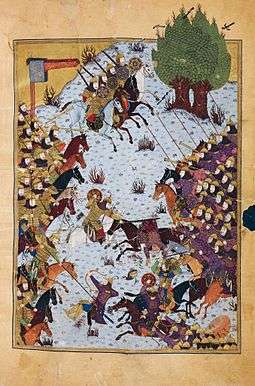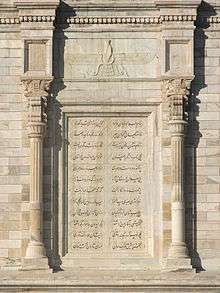Baysonghor Shahnameh

The Baysonghor Shahnameh (Persian: شاهنامه بایسُنغُری) is an illustrated manuscript of the Shahnameh, the national epic of Greater Iran. The work on this manuscript was started in 1426 at the order of Baysonghor Mirza, the Timurid prince, and was completed on 1430, four years later. It is now in the museum of Golestan Palace, Iran, and regarded as a key masterpiece of the Persian miniature.
According to the preface, apparently written by Baysonghor himself for this volume, and usually copied in later manuscripts,[1] it is not a copy of a previous manuscript, it is prepared by comparing several older manuscripts. But the purpose of this comparison was not to achieve greater fidelity to Ferdowsi's original Shahnameh, it was to modernize the language of the text and to add verses to it. Because of this, the Baysonghor Shahnameh is one of the most voluminous manuscripts of Shahnameh, consisting of some 58,000 verses (today's version of Shahnameh consists of about 50,000 verses). The value of this manuscript is not because of its text, but on its artistry. Written in Nastaʿlīq script, it has 346 pages and 21 miniatures of the Herat School and is one of the most important works in this school. Beside the Demotte Shahnameh and the Shahnameh of Shah Tahmasp, the Baysonghor Shahnameh is one of the most important and famous manuscripts of the Shahnameh.[2]
It is included in UNESCO's Memory of the World Register of cultural heritage items.[3]
Miniatures
It is likely that Baysonghor chose the 21 subjects for the miniatures himself; several are unusual choices for illustrations, and on subjects relevant to a prince impatient to inherit (which he never did). The frontispiece shows a prince who was probably a portrait of Baysonghor. At about 38 x 26 cm, the page size was unusually large for the period, and several miniatures fill the whole page, with the frontispiece across two pages; in both these respects, the manuscript shows the direction later royal commissions would take. [4]
Notes
| Wikimedia Commons has media related to Baysunghur's Shahnameh. |
- ↑ Titley, 54
- ↑ "BĀYSONḠORĪ ŠĀH-NĀMA". Iranica. Retrieved 13 February 2016.
- ↑ ""Bayasanghori Shâhnâmeh" (Prince Bayasanghor’s Book of the Kings)". UNESCO. Retrieved 28 May 2012.
- ↑ Blair and Bloom, 59
References
- Blair, Sheila, and Bloom, Jonathan M., The Art and Architecture of Islam, 1250-1800, 1995, Yale University Press Pelican History of Art, ISBN 0300064659
- Canby, Sheila R., Persian Painting, 1993, British Museum Press, ISBN 9780714114590
- Piotrovsky M.B. and Rogers, J.M. (eds), Heaven on Earth: Art from Islamic Lands, 2004, Prestel, ISBN 3791330551
- Titley, Norah M., Persian Miniature Painting, and its Influence on the Art of Turkey and India, 1983, University of Texas Press, ISBN 0292764847
- Welch, Stuart Cary. Royal Persian Manuscripts, Thames & Hudson, 1976, ISBN 0500270740

_-_Walters_W60276B_(cropped).jpg)



.png)